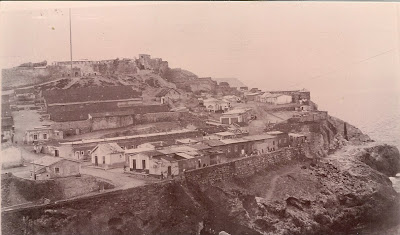Rosario's forte was a stronghold of masonry built in the mid 1730's and closed, along with the Cutting of his name, the fourth site by its apex north. It is located forefront of Fort Victoria and served Grande flank defense. It was originally isolated from Great Victoria and communicated through an underground branch. Later we built a wall with loopholes that bound and after the siege of 1774-1775, given the need to strengthen the defenses of the city, became such a wall in a battery.
 (FRONT OF STRONG ROSARIO, THE GREAT VICTORY FUND)
(FRONT OF STRONG ROSARIO, THE GREAT VICTORY FUND) Along with the strengths of Victoria Grande and Chica, bore much of the weight of the siege of 1774-1775, under attack from the mines Moroccan who came to blow up a stove in the vicinity of Rosario on January 16, 1775, bombing that did not produce damages in the fort. Threats since the attack of the lace, their defenders were several casualties from bomb and shell fire. January 19, 1775, for example, Jaime Suñé, San Antonio xebec sailor reinforcing the garrison of the fort, was shot and fell Antonio Concha mortally wounded by shrapnel from an artillery impact. The Rosary was the place where on the night of March 16, 1775, a English renegade those who have served the Moroccan sultan tried to desert and benefit from the square but was captured by the Moroccans when heading to the fort. On the other hand, since this was also strong garrison soldiers who deserted and Melilla Juan Bautista José Charluis Beberacho and they did the March 2, 1777.
With the end of the siege ended Moroccan attacks and skirmishes suffered by the Rosary.
On September 12, 1790 Grande Rosario and Victoria were attacked with hand grenades. On June 23, 1791 is repeated hand grenade attack on 19 August of that year he was mortally wounded while stationed at Fort Lorenzo Daplat, the regiment of Brabant and December 17 guelayenses tried to burn the stockade Rosario but were repulsed suffering several casualties and leaving a corpse in the field. The corpse was rescued after paying a cow, three calves and two rams.
In the pages of the "Records and curiosities of Melilla, and Alhucemas Penon" collected by Gabriel Morales, soldiers found many reviews that being on guard or garrison at the fort of the Rosary were killed by snipers guelayenses. The last of these casualties occurred on September 19, 1871 when he was mortally wounded in the regiment Jerome Santiago Espinosa de Valencia. Of note, several years ago they had set the limits of the present territory of Melilla.

(BATTERY AND PIT DEL ROSARIO, THE GREAT VICTORY FUND).
snipers were not the only threat looming on the Rosary. The proximity of the attacks and Dry Puntilla favored ambush soldiers and countrymen that stretched from the protection of the fort. On February 26, 1772, Juan Hermosa went hunting to the ravine, which would be the actual street Lobera Candide, where he was killed by the guelayenses. On March 19, 1789, about guelayenses approached the fort with the pretext of selling chickens and when two soldiers came to buy attacked them, injuring both.
The need for repairs to the fort, was the subject of a victorious exit from the garrison in Melilla on November 7, 1849. This was to ensure the land to build a parapet of sandbags to cover the workers responsible for repairs. The troops left three columns in San Ramon and Rosario, Rake of Spades and Mantelete. It took all the attacks that surrounded the square and the English vanguard occupied and looted the headquarters of Santiago guelayense standing at the back of the current La Salle College. Raised the parapet that would work safely on the walls of the Rosary, it was ordered that the troops withdraw.
This photo of the ruined back of the battery Rosario allows us to see the structure of it. Presented a considerable wall thickness was the enemy camp and a vaulted gallery in the sea. The space between was filled with compacted rubble on which set the floor of the battery.
A military helicopter flies over the fort of the Rosary. Past and present the defense of our city come together. With control of the present territory of Melilla and the construction of the strong field, the Rosary lost its function of forward defense of Melilla and gradually was relegated to neglect and oblivion.















